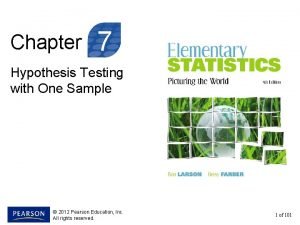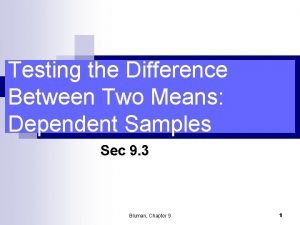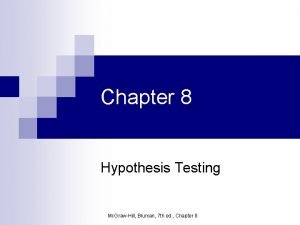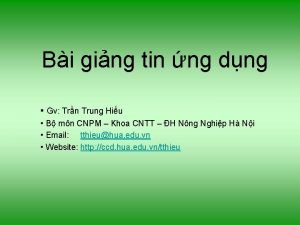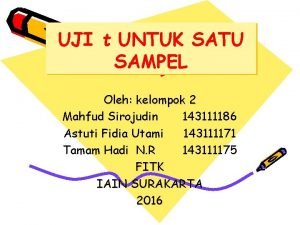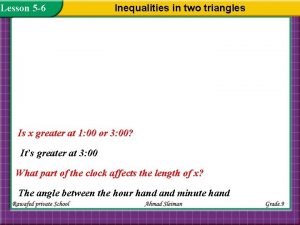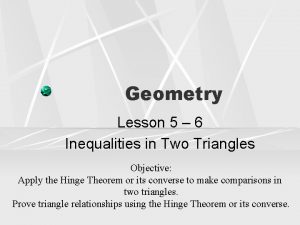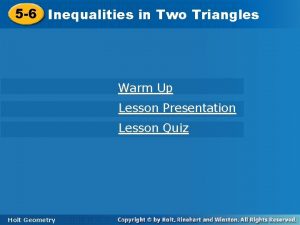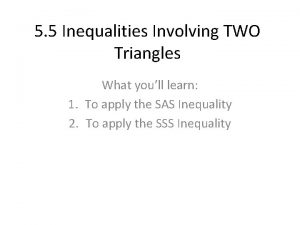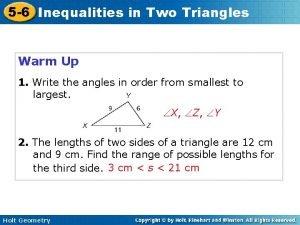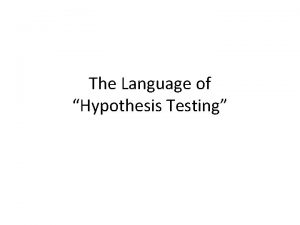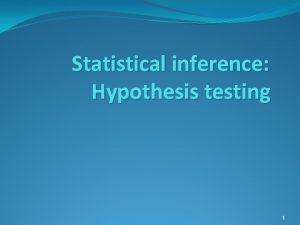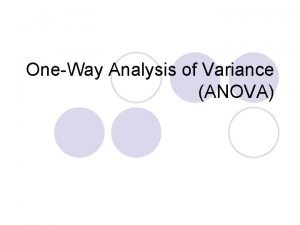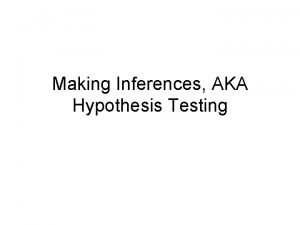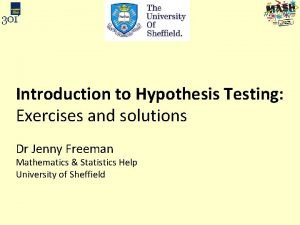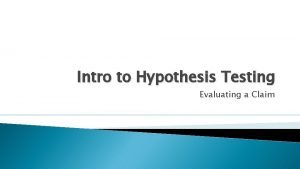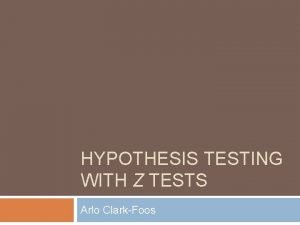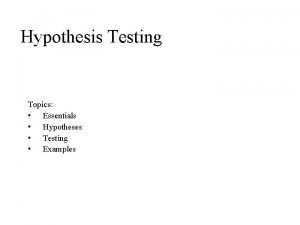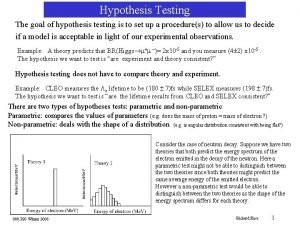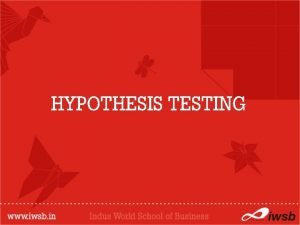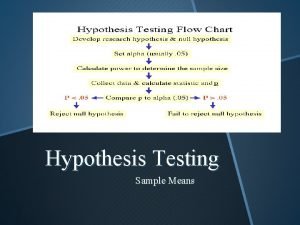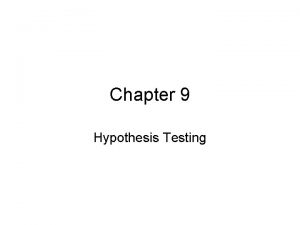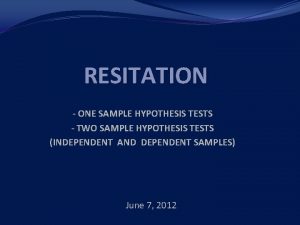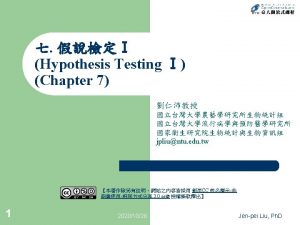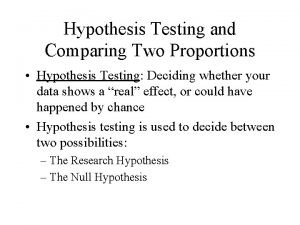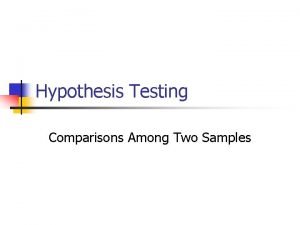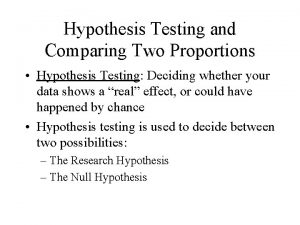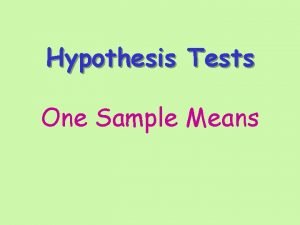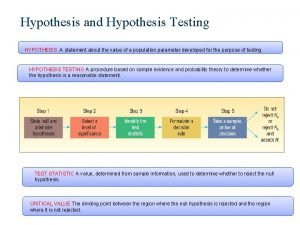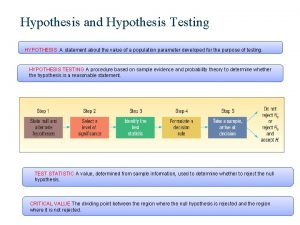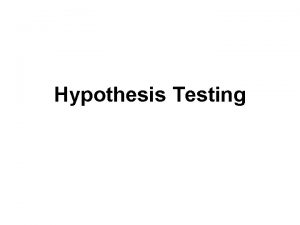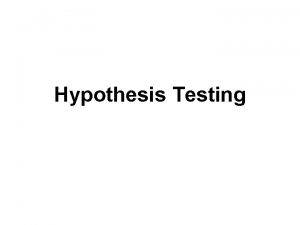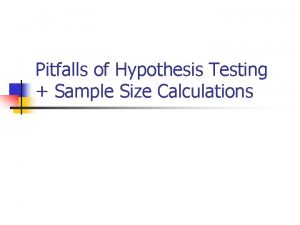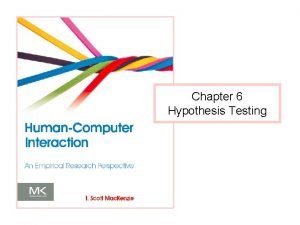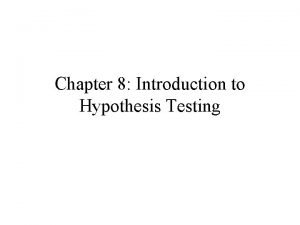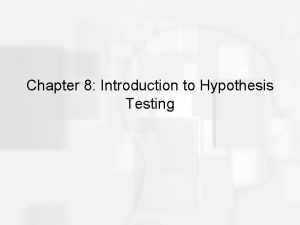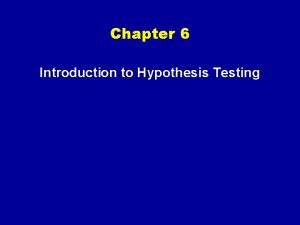CHAPTER 11 Hypothesis Testing Involving Two Sample Means
























- Slides: 24

CHAPTER 11: Hypothesis Testing Involving Two Sample Means or Proportions to accompany Introduction to Business Statistics fourth edition, by Ronald M. Weiers Presentation by Priscilla Chaffe-Stengel Donald N. Stengel © 2002 The Wadsworth Group

Chapter 11 - Learning Objectives • Select and use the appropriate hypothesis test in comparing – – Means of two independent samples Means of two dependent samples Proportions of two independent samples Variances of two independent samples • Construct and interpret the appropriate confidence interval for differences in – Means of two independent samples – Means of two dependent samples – Proportions of two independent samples © 2002 The Wadsworth Group

Chapter 11 - Key Terms • Independent vs dependent samples • Pooled estimate of the – common variance – common standard deviation – population proportion • Standard error of the estimate for the – difference of two population means – difference of two population proportions • Matched, or paired, observations • Average difference © 2002 The Wadsworth Group

Independent vs Dependent Samples • Independent Samples: Samples taken from two different populations, where the selection process for one sample is independent of the selection process for the other sample. 1. Dependent Samples: Samples taken from two populations where either (1) the element sampled is a member of both populations or (2) the element sampled in the second population is selected because it is similar on all other characteristics, or “matched, ” to the element selected from the first population © 2002 The Wadsworth Group

Examples: Independent versus Dependent Samples • Independent Samples: – Testing a company’s claim that its peanut butter contains less fat than that produced by a competitor. • Dependent Samples: – Testing the relative fuel efficiency of 10 trucks that run the same route twice, once with the current air filter installed and once with the new filter. © 2002 The Wadsworth Group

Identifying the Appropriate Test Statistic Ask the following questions: • Are the data from measurements (continuous variables) or counts (discrete variables)? • Are the data from independent samples? • Are the population variances approximately equal? • Are the populations approximately normally distributed? • What are the sample sizes? © 2002 The Wadsworth Group

Test of (µ 1 – µ 2), s 1 = s 2, Populations Normal • Test Statistic [x – x ] – [m – m ] t = 1 2 æ 1 ö 2 0 ç ÷ ç 1 + 1 ÷ 2 sp çn n ÷ çç ÷÷ è 1 2ø (n – 1)×s 2 + (n – 1)×s 2 1 2 2 where s p 2 = 1 n +n – 2 1 2 and df = n 1 + n 2 – 2 © 2002 The Wadsworth Group

Example: Equal-Variances t-Test • Problem 11. 2: An educator is considering two different videotapes for use in a half-day session designed to introduce students to the basics of economics. Students have been randomly assigned to two groups, and they all take the same written examination after viewing the videotape. The scores are summarized below. Assuming normal populations with equal standard deviations, does it appear that the two videos could be equally effective? What is the most accurate statement that could be made about the p-value for the test? Videotape 1: = 77. 1, s 1 = 7. 8, n 1 = 25 Videotape 2: = 80. 0, s 2 = 8. 1, n 2 = 25 x 2 © 2002 The Wadsworth Group

t-Test, Two Independent Means • I. H 0: µ 1 – µ 2 = 0 The two videotapes are equally effective. There is no difference in student performance. H 1: µ 1 – µ 2 ¹ 0 The two videotapes are not equally effective. There is a difference in student performance. • II. Rejection Region a = 0. 05 df = 25 + 25 – 2 = 48 Reject H 0 if t > 2. 011 or t < – 2. 011 © 2002 The Wadsworth Group

t-Test, Problem 11. 2 cont. • III. Test Statistic 2 + 24×(8. 1)2 1460. 16 + 1564. 64 × 24 ( 7. 8 ) = = 63. 225 s p 2 = 25 + 25 – 2 48 t= x –x 1 2 æ ç ç ç è s p 2 1 + 1 n n 1 2 ö ÷ ÷ ÷ ø = 77. 1– 80. 0 = – 1. 289 æ ö ç 1 ÷ 1 63. 225çç + ÷÷ è 25 25 ø © 2002 The Wadsworth Group

t-Test, Problem 11. 2 cont. 1. IV. Conclusion: Since the test statistic of t = – 1. 289 falls between the critical bounds of t = ± 2. 011, we do not reject the null hypothesis with at least 95% confidence. 1. V. Implications: There is not enough evidence for us to conclude that one videotape training session is more effective than the other. 1. p-value: Using Microsoft Excel, type in a cell: =TDIST(1. 289, 48, 2) The answer: p-value = 0. 203576 © 2002 The Wadsworth Group

Test of (µ 1 – µ 2), Unequal Variances, Independent Samples • Test Statistic © 2002 The Wadsworth Group

Example, Unequal-Variances t-Test, Independent Samples • Suppose analysis of two independent samples from normally distributed populations reveal the following values: What degrees of freedom should be used on the unequal-variances t-test of the differences in their means? © 2002 The Wadsworth Group

Example, Calculation of the Degrees of Freedom for the t-Test So we would use a t-test with 62 degrees of freedom to test the differences in the means of the two populations. © 2002 The Wadsworth Group

Test of Independent Samples (µ 1 – µ 2), s 1 ¹s 2, n 1 and n 2 ³ 30 • Test Statistic [x – x ]–[m – m ] 1 20 z = 1 2 s 2 1 + 2 n n 1 2 – with s 12 and s 22 as estimates for s 12 and s 22 © 2002 The Wadsworth Group

Test of Dependent Samples (µ 1 – µ 2) = µd • Test Statistic t=s d d n – where d = (x 1 – x 2) = Sd/n, the average difference n = the number of pairs of observations sd = the standard deviation of d df = n – 1 © 2002 The Wadsworth Group

Test of (p 1 – p 2), where n 1 p 1³ 5, n 1(1–p 1)³ 5, n 2 p 2³ 5, and n 2 (1–p 2 )³ 5 • Test Statistic – where p 1 = observed proportion, sample 1 p 2 = observed proportion, sample 2 n 1 = sample size, sample 1 n 2 = sample size , sample 2 n p + n p 2 2 p = 1 1 n + n 1 2 © 2002 The Wadsworth Group

Testing for Equal Variances • Pooled-variances t-test assumes the two population variances are equal. • The F-test can be used to test that assumption. • The F-distribution is the sampling distribution of s 12/s 22 that would result if two samples were repeatedly drawn from a single normally distributed population. © 2002 The Wadsworth Group

Test of s 12 = s 22 • If s 12 = s 22 , then s 12/s 22 = 1. So the hypotheses can be worded either way. s 2 2 • Test Statistic: is larger F = 1 orwhichever 2 2 s s • The critical value of the F 2 will be 1 F(a/2, n 1, n 2) – where a = the specified level of significance n 1 = (n – 1), where n is the size of the sample with the larger variance n 2 = (n – 1), where n is the size of the sample with the smaller variance © 2002 The Wadsworth Group

Testing for Equal Variances An Example Returning to Problem 11. 2, let us test with 95% confidence whether it was reasonable for us to assume that the two population variances were approximately equal. I. H 0: s 22/s 12 = 1 H 1: s 22/s 12 ¹ 1 II. Rejection Region a/2 = 0. 025 numerator df = 24 denominator df = 24 If F > 2. 27, reject H 0, meaning it was not reasonable for us to assume the population variances were approximately equal. © 2002 The Wadsworth Group

Testing for Equal Variances An Example, cont. III. Test Statistic s 2 2 F = 2 = 8. 1 = 1. 0784 s 2 7. 82 1 IV. Conclusion Since the test statistic of F = 1. 078 falls below the critical value of F = 2. 27, we do not reject H 0 with at most 5% error. V. Implications There is not enough evidence to support a conclusion that the two populations have different variances. The pooled variances t-test can be used in analyzing these data. © 2002 The Wadsworth Group

Confidence Interval for (µ 1 – µ 2) • The (1 – a)% confidence interval for the difference in two means: – Equal-variances t-interval æ ç ç ç ç è 1 1 (x – x ) ± t a × s 2 + p 1 2 2 n n 1 2 ö ÷ ÷ ÷ ÷ ø – Unequal-variances t-interval s 2 (x – x ) ± t a × 1 + 2 1 2 n 1 2 © 2002 The Wadsworth Group

Confidence Interval for (µ 1 – µ 2) • The (1 – a)% confidence interval for the difference in two means: – Known-variances z-interval © 2002 The Wadsworth Group

Confidence Interval for (p 1 – p 2) • The (1 – a)% confidence interval for the difference in two proportions: p (1– p ) 1 + 2 2 (p – p ) ± z a × 1 1 2 n n 2 1 2 – when sample sizes are sufficiently large. © 2002 The Wadsworth Group
 Chapter 7 hypothesis testing with one sample answers
Chapter 7 hypothesis testing with one sample answers Great gatsby chapter 3 questions
Great gatsby chapter 3 questions A dietitian wishes to see if a person's cholesterol
A dietitian wishes to see if a person's cholesterol Chapter 8 hypothesis testing
Chapter 8 hypothesis testing Z test two sample for means
Z test two sample for means Contoh soal uji t satu sampel
Contoh soal uji t satu sampel Example of alternative hypothesis
Example of alternative hypothesis Null hypothesis vs alternative hypothesis
Null hypothesis vs alternative hypothesis Accept or reject hypothesis
Accept or reject hypothesis Weakness of protoplanet hypothesis
Weakness of protoplanet hypothesis Hinge theorem activity
Hinge theorem activity 5-6 inequalities in two triangles worksheet answers
5-6 inequalities in two triangles worksheet answers 5-6 inequalities in two triangles worksheet answers
5-6 inequalities in two triangles worksheet answers Inequalities involving two triangles
Inequalities involving two triangles 5-6 inequalities in two triangles
5-6 inequalities in two triangles The language of hypothesis testing
The language of hypothesis testing P-value interpretation
P-value interpretation One way anova
One way anova Hypothesis testing assignment
Hypothesis testing assignment Hypothesis testing exercises and solutions
Hypothesis testing exercises and solutions Critical value hypothesis testing
Critical value hypothesis testing Assumptions for hypothesis testing
Assumptions for hypothesis testing Hypothesis testing formula
Hypothesis testing formula Goal of hypothesis testing
Goal of hypothesis testing Difference between type 1 and type 2 error
Difference between type 1 and type 2 error
